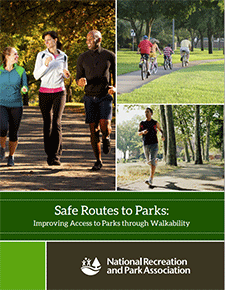The month of May represents many things for park and recreation agencies across the country. School is winding down and summer vacation is about to begin, cheers from the baseball and softball fields ring through neighborhoods and new gardens are planted with hopes of yielding a summer full of fresh fruits and vegetables! Local parks become the centerpieces in hundreds of communities throughout the spring; they serve as gathering places for friends and families to BBQ or play a game of volleyball, they offer a place to cool off with a dip in the pool, some even hold summer concerts and outdoor movies. Parks have the ability to bring together communities to experience a plethora of health and wellness activities! With so many amazing programs taking place at parks, it’s important to consider one important factor in particular — how are your community members getting to your parks?!
 NRPA recently published a Safe Routes to Parks: Improving Access to Parks through Walkability report that lists five essential elements to take into account when creating safe routes to parks — Comfort, Convenience, Safety, Access and Design, and The Park. Are residents comfortable walking to their local park? Is it convenient? Is safety a concern? Can each and every member of your community access the park? Does the park have the amenities and programs that the community wants and needs? These five elements are key considerations to make when evaluating how people are accessing your parks today, and in the future.
NRPA recently published a Safe Routes to Parks: Improving Access to Parks through Walkability report that lists five essential elements to take into account when creating safe routes to parks — Comfort, Convenience, Safety, Access and Design, and The Park. Are residents comfortable walking to their local park? Is it convenient? Is safety a concern? Can each and every member of your community access the park? Does the park have the amenities and programs that the community wants and needs? These five elements are key considerations to make when evaluating how people are accessing your parks today, and in the future.
Let's take a more in-depth look at the five elements of a safe route to a park.
• Comfort: The conditions of your sidewalks and aesthetics including providing shade in especially warm areas, offering proper lighting for evening activities, ensuring low traffic volume and developing off-road trail access are key items to consider when determining access to parks.
• Convenience: Pedestrian routes to parks need to be in close proximity to where residents live. The route should be within a 10-minute walk from major residential areas. Appropriate site selection of new parks is an extremely important factor when determining future plans.
• Safety: Ensuring pedestrian safety is of the utmost importance. Separating pedestrian paths from roads so that pedestrians are not competing with automobiles, providing adequate lighting, ensuring seasonal maintenance (winter especially) and maintaining the infrastructure will lead to a more user-friendly environment.
• Access and Design: Proper design benefits all users and allows all citizens to use safe routes to parks. All walkways at intersections should be reviewed for ADA compliance. Ensuring multiple access points to parks is also important to consider.
• The Park: A critical element to building a safe route to a park is the actual park itself. The park must offer the amenities that the community wants and the population will use. Evaluate your population (older adults, young families, young adults) and establish your park as a health and wellness center for your community members and their needs.
It’s important that we take these items into consideration when planning park infrastructure and thinking about future programming opportunities in our communities. By incorporating the strategies above we can ensure that all of our community members have easy access to parks, a safe way to get there and the opportunity to participate in abundance of health and wellness activities.
Can your community safely walk to your parks? What are you doing to improve the walkability to your parks? Leave a comment below or tweet us @NRPA_news.
Allison Colman is NRPA's Program Manager.

